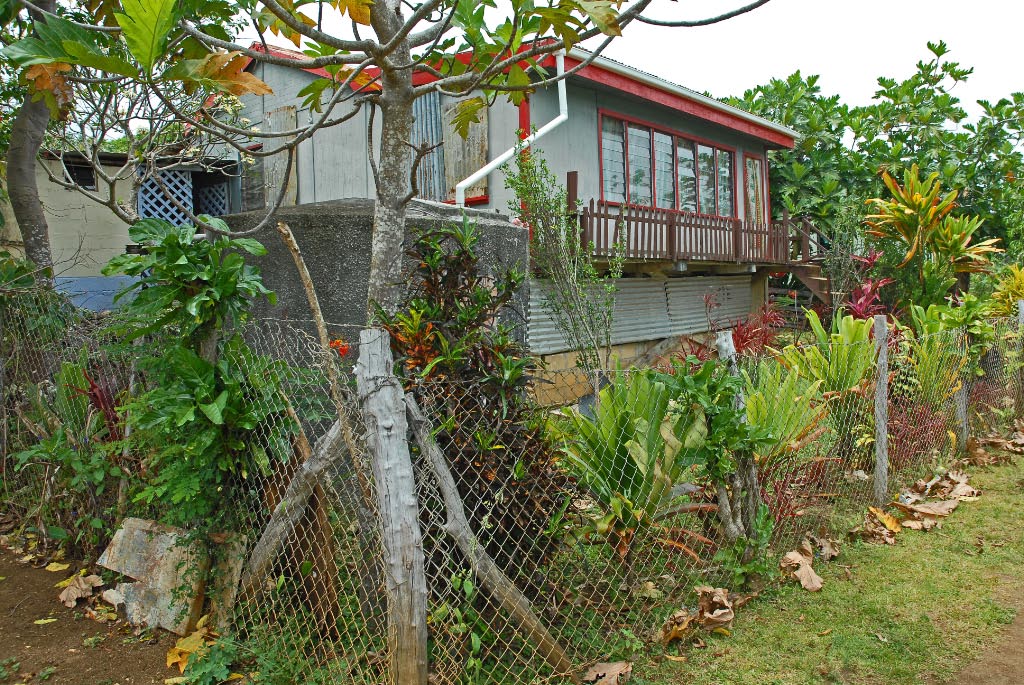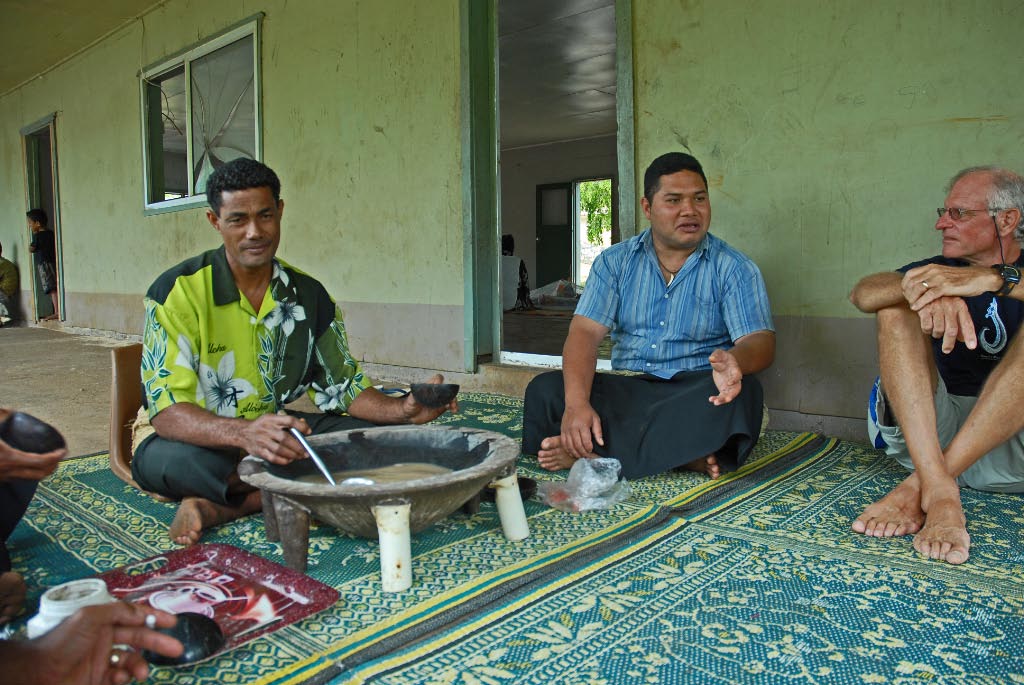 We arrived shortly after noon for the Tongan feast. We wondered through the village with our hostess, Fa’aki, and several of her children. Ben, her husband, met us half way, apologizing for not greeting us. Ben and Fa’aki were the host family for today’s feast and were busily preparing and organizing food. We continued wandering through the village, a series of houses, public buildings, and churches. Nicer buildings were concrete, houses were a combination of brick walls, wood slats, and corrugated tin, sometimes all on the same house. Most houses were surrounded by extensive gardens, both food and flowers. No need for a landscaper here, the locals did a beautiful job. Dogs, pigs, and even horses run free. Most of the houses were fenced, with a section of low wall to allow people to cross into the yard. I initially thought it was to keep the dogs out, and was amused when they hopped over with ease. I don’t think I’d ever actually seen a pig stile before but I remember them from childhood stories. They work well keeping the pigs out of yards, and nobody ever has to yell at the kids to shut the gate.
We arrived shortly after noon for the Tongan feast. We wondered through the village with our hostess, Fa’aki, and several of her children. Ben, her husband, met us half way, apologizing for not greeting us. Ben and Fa’aki were the host family for today’s feast and were busily preparing and organizing food. We continued wandering through the village, a series of houses, public buildings, and churches. Nicer buildings were concrete, houses were a combination of brick walls, wood slats, and corrugated tin, sometimes all on the same house. Most houses were surrounded by extensive gardens, both food and flowers. No need for a landscaper here, the locals did a beautiful job. Dogs, pigs, and even horses run free. Most of the houses were fenced, with a section of low wall to allow people to cross into the yard. I initially thought it was to keep the dogs out, and was amused when they hopped over with ease. I don’t think I’d ever actually seen a pig stile before but I remember them from childhood stories. They work well keeping the pigs out of yards, and nobody ever has to yell at the kids to shut the gate.
The six of us from Nine-of-Cups, Gannet, and Yohelah were the only non-villagers there. We arrived at the community center, a large, empty shell of a house built from concrete with a few broken windows and flopping doors. The weather is mild enough here that few of the buildings have working windows and doors. Often fabric does the job well. You’d look at the community center and most of the houses and think, “hmm, could use a little paint…”, but while there isn’t always spare glass to fix broken panes or spare money to buy enough paint to do the whole village, everything is clean. As we walked in I noticed the woven mats on the floor and the beginnings of the food spread, placed down the middle of a forty foot run of mats laid end-for-end. David and John headed for the back porch, I followed.
There were a dozen men on the porch, sitting cross legged in a rough circle. They opened up the circle, allowing us to join them. At one end of the circle was a large wooden bowl with legs carved from the same piece of wood as the bowl. Two of the legs were broken and had been replaced with sections of PVC pipe. The liquid in the bowl looked like weak coffee with milk. There was a metal ladle clinging to the edge of the bowl. As I sat I noticed two things about the circle of men drinking kava. The first was that the three of us palangis were the only ones actually sitting on the ground, everyone else was sitting on one-piece plastic chairs with the metal legs removed. The other was the head of the circle wasn’t the kava bowl. While the bowl may have been the focal point, the head of the circle was at the other end, where the village chief sat.
Tongan men wear western style shirts and a ta’ovala, or plaited mat, around the waist, over a longer kilt called a vala or tupenu. The social standing of elders is shown by the style and richness of the ta’ovala. In our circle, all men were wearing collared shirts of brightly colored fabrics; most of the ta’ovalas were basic tan woven mats. The village chief was wearing a brighter ta’ovala of purple fabric over a tupenu of dark blue. His look was finished off by a pair of very dark sunglasses. He was bracketed by two of the five church ministers in the village, equally well dressed but with plainer ta’ovalas. You could have plopped the three of them down on a red carpet in LA, added a few gold accessories, and passed them off as a famous rapper and his retinue. I’m sure the thought would appall them all.
 One last thing about the circle, the men were seated in order of social standing. The older men were around the chief, at the other end were the younger men. When we asked how the server was chosen, expecting some complicated selection process based on an ancient reward system, we were told it was whoever got there first and wanted to sit in front of the bowl. The cups were half-coconut shells. A round of drinking was started by the chief, who would throw his cup across the middle of the circle, sliding it up to the bowl. This would prompt everyone else to toss their cup into the circle and up to the bowl. Everyone knew which coconut half belonged to whom, with the cups filled and passed back in order. Kava is not sipped, but rather gulped, most cups emptied in one swift motion. Having heard so many stories about the awful taste of kava, I did take an experimental sip before I committed to upending my coconut shell. It wasn’t bad. It tasted a bit like a slightly bitter tea. After upending the cup it took a few short minutes for my mouth and throat to feel numb. Strange but I felt like I was ready for the dentist. Having never tried kava before, I have no idea how a day of drinking would feel; I managed three rounds and did not proceed past the numbing of mouth and throat. The locals seemed a little unsteady as they came and went, but none acted overtly intoxicated.
One last thing about the circle, the men were seated in order of social standing. The older men were around the chief, at the other end were the younger men. When we asked how the server was chosen, expecting some complicated selection process based on an ancient reward system, we were told it was whoever got there first and wanted to sit in front of the bowl. The cups were half-coconut shells. A round of drinking was started by the chief, who would throw his cup across the middle of the circle, sliding it up to the bowl. This would prompt everyone else to toss their cup into the circle and up to the bowl. Everyone knew which coconut half belonged to whom, with the cups filled and passed back in order. Kava is not sipped, but rather gulped, most cups emptied in one swift motion. Having heard so many stories about the awful taste of kava, I did take an experimental sip before I committed to upending my coconut shell. It wasn’t bad. It tasted a bit like a slightly bitter tea. After upending the cup it took a few short minutes for my mouth and throat to feel numb. Strange but I felt like I was ready for the dentist. Having never tried kava before, I have no idea how a day of drinking would feel; I managed three rounds and did not proceed past the numbing of mouth and throat. The locals seemed a little unsteady as they came and went, but none acted overtly intoxicated.
Communication was slow. The older gentleman to my right would only nod politely but not actually speak to me. Actually I didn’t hear him speak English to anyone, so perhaps my lack of Tongan was the problem. On my other side was one of the church ministers. He looked a bit like Eddie Murphy and our conversation was a series of brief mumbled comments spaced out over enough time I’d forget we were having a conversation. If I had to ask more than twice for him to repeat himself I’d resort to nodding politely and pretending I knew what he’d said. I did learn his church was very similar to our Methodists. He asked me if I was Christian, or… after a long pause, a heathen. His mischievous grin gave him away, but I was still happy to report I wasn’t heathen.
Most of our conversation and information came from Moses, a local school teacher who David had helped the day before with the solar panels on his house. Moses was young and outgoing with a giggling laugh. He was a lot of fun and very informative. He answered many questions about Tongan society and the people of his village. He also let us know the kava ‘ceremony’ had started at 9 that morning. We joined about half past one. I think that explained a few things, including the slow pace of conversation.
We sat on the porch for a couple of hours, watching platter after platter of food go by. Since our levels of narcotic-induced euphoria did not match that of our hosts, us three palangis had a lot of time between conversational lapses to watch the food deliveries and ponder solutions to the world’s woes. At one point the kava bowl arrived at an alarmingly low level, a situation rectified by a youngster showing up with a bucket of kava which was strained into our bowl. Whew! Disaster averted.
The dinner bell soon rang and everyone headed into the hall for the feast that had been meticulously laid out for us while we were lounging on the porch. Not a bad life, especially when you consider this was a weekday and no one seemed to have needed an excuse for the boss to get away from work.